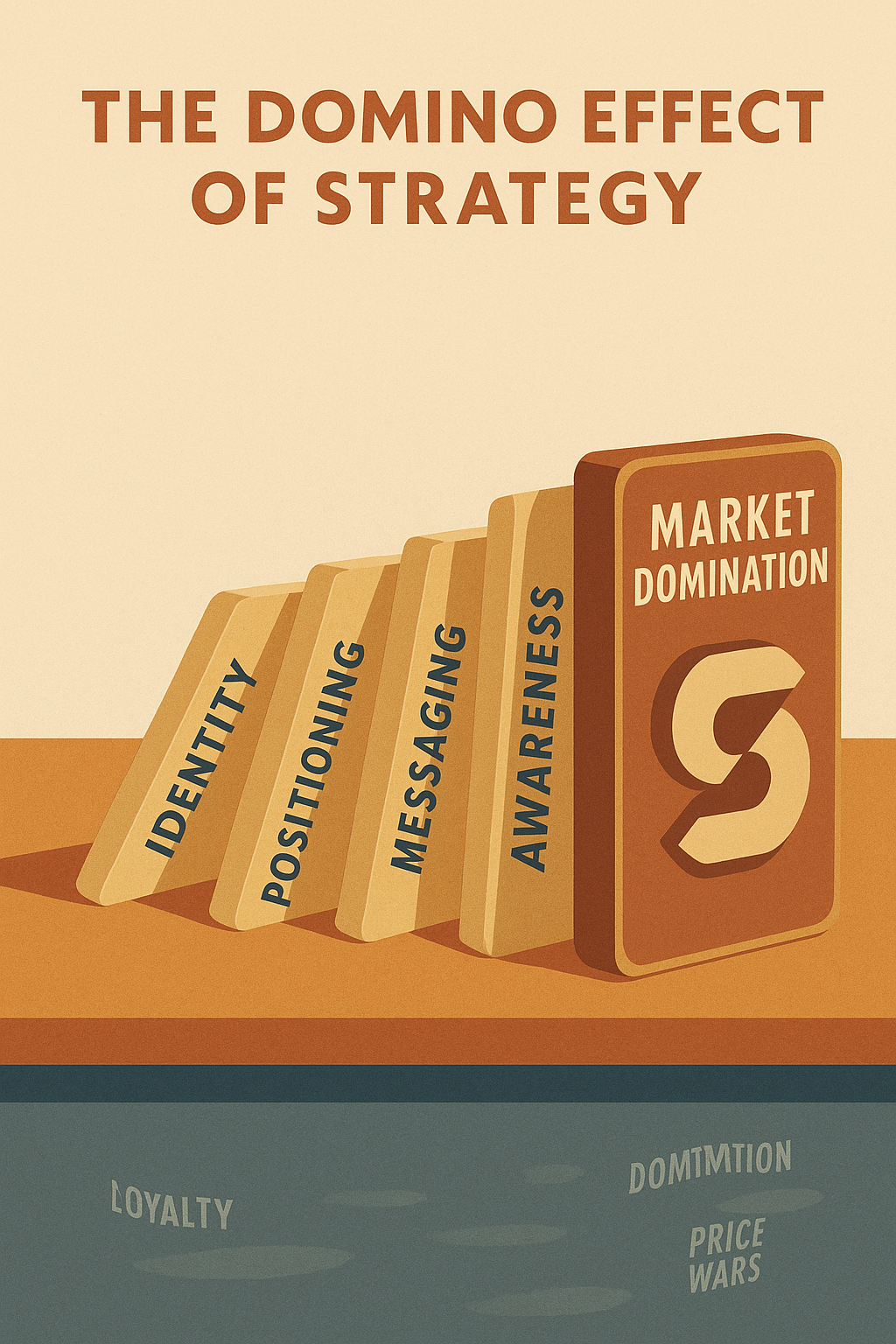You’ve got a cutting-edge product or service, a vision for success, and a drive to build a powerhouse brand—but here’s the catch: no one’s paying attention.
It’s not because your business lacks potential or your offer isn’t valuable.
The real problem?
Your brand strategy isn’t sharp enough to cut through the noise.
Truth is, even the best brands don’t succeed just because of good branding—they thrive because they have a comprehensive brand strategy that makes their brand identity unforgettable.
They don’t just sell products, they build trust and loyalty, stand out from the competition, and create a deep emotional connection with their target audience.
Without an effective brand strategy, even the most innovative businesses struggle to make an impact in an oversaturated market.
I’m Viktor, a brand strategist who has spent over a decade working with top-tier brands, helping them refine their brand positioning, craft their brand message, and turn their vision into a successful brand strategy that drives business success.
This guide? It’s going to walk you through the key elements of a strong brand strategy, how to develop a unique identity, and the steps to building a brand that not only attracts potential customers but turns them into loyal advocates. Whether you’re launching a new brand, refining an existing one, or repositioning your brand voice to better resonate with your customer base, this is the roadmap you need.
Ready to build a brand strategy that lasts? Let’s dive in.
What is a Brand Strategy? (Defining the Core Concept)
A brand strategy is the structured, long-term plan that defines how a brand exists, grows, and communicates with its target market. It is more than just an aesthetic or a catchy brand name—a successful brand strategy encompasses everything from brand values and brand personality to marketing efforts and customer experience.
A strong brand strategy acts as the guiding framework for how a business presents itself, builds brand recognition, and maintains customer loyalty over time. It helps businesses create a strong visual identity, craft a compelling brand story, and execute marketing strategies that make a lasting impact.
In 2024, where digital competition is fierce and consumers expect meaningful engagement, a good brand strategy can help businesses stand out, resonate with their audience, and create long-term success. Without a clear brand positioning statement and brand guidelines, even the best products can struggle to gain traction.
The Difference Between Branding and Brand Strategy
Many businesses confuse branding with brand strategy, but the two are fundamentally different.
Branding: The Visual and Emotional Identity
Branding refers to the visual elements and emotional perception that shape how a company is recognized. This includes:
- Visual identity (logos, colors, typography)
- Tone of voice (how the brand communicates)
- Brand personality (how the brand feels to customers)
A brand’s look—from website design to packaging—is a crucial part of branding, but without a brand strategy, it lacks direction.
Brand Strategy: The Foundation of a Successful Brand
A brand strategy is the overarching plan that defines how a brand builds relationships, positions itself in the market, and creates a unique selling proposition. It includes:
- Brand positioning statement (where the brand stands among competitors)
- Core values and mission statement (what the brand represents)
- Marketing and branding strategies (how the brand reaches its audience)
- Customer experience and loyalty (how the brand interacts with its audience)
In short, brand strategy encompasses everything that makes a brand unique, recognizable, and successful in its industry. While branding creates a strong brand identity, it is the brand strategy that ensures it thrives in the long term.
Examples of Successful Brand Strategies
Some of the most powerhouse brands in the world today have built their success on solid brand strategies. Let’s take a closer look at three standout examples:
Apple: The Power of Brand Equity and Consistency
Apple’s brand strategy for business success focuses on simplicity, innovation, and premium positioning. Every aspect of its brand development—from product design to marketing—reinforces a minimalist yet high-quality appeal. Its brand equity allows it to charge premium prices and maintain a fiercely loyal customer base. Learn how to build brand equity for your brand.
Nike: Emotional Branding and Strong Brand Identity
Nike’s brand story revolves around inspiration, motivation, and achievement. Through powerful marketing campaigns, endorsements, and emotional storytelling, Nike has built a successful brand strategy that resonates globally. Their content marketing efforts consistently reinforce their brand values, making them one of the world’s most recognizable powerhouse brands.
Tesla: Disruptive Brand Positioning and Innovation
Tesla’s brand strategy requires a unique approach—disrupting traditional industries and focusing on sustainability, innovation, and futuristic technology. By positioning itself as a leader in electric vehicles and clean energy, Tesla has created a brand personality that appeals to environmentally-conscious and tech-savvy customers.
A successful brand strategy is not just about having a great brand name or an attractive logo—it’s about having a long-term plan that defines your business strategy, marketing approach, and customer experience. Every successful brand strategy starts with clear brand positioning, a compelling brand message, and a well-defined tone of voice.
Now that we’ve defined what a brand strategy is and why it matters, let’s explore the elements of a brand strategy and the steps to building a brand that lasts.

Why a Strong Brand Strategy is Crucial for Business Success
A strong brand strategy is not just about aesthetics or having a memorable brand name—it’s about creating a powerhouse brand that resonates with customers, builds trust, and ensures long-term business success. Whether you’re a startup or an established company, a well-defined brand strategy for your business helps you build a brand that is recognizable, consistent, and set apart from the competition.
In 2024, brands must adapt to evolving marketing channels, embrace digital marketing, and ensure their branding efforts align with consumer expectations. A strong brand strategy ensures your brand development remains relevant, consistent, and effective across all platforms. Let’s take a closer look at why a comprehensive brand strategy is essential for business success.
Drives Brand Awareness & Recognition
(Why powerhouse brands like Coca-Cola and McDonald’s dominate.)
A well-executed brand strategy helps businesses build brand awareness and brand recognition, ensuring they remain top-of-mind for their target audience. Powerhouse brands like Coca-Cola, McDonald’s, and Apple have mastered brand development by creating a consistent identity that resonates with customers.
How Brand Awareness Helps Business Growth
- Increases Visibility: The more people recognize and trust your brand, the more likely they are to choose you over similar products or services.
- Boosts Customer Acquisition: A strong brand strategy makes your brand easily identifiable, helping attract new customers.
- Strengthens Market Positioning: Brands with strong brand awareness can command higher prices and customer loyalty.
Example of a Brand with Strong Awareness
Coca-Cola’s brand strategy relies on consistent branding efforts, emotional storytelling, and strategic marketing campaigns. Whether through product branding, digital ads, or sponsorships, Coca-Cola ensures its brand looks and feels the same across all marketing channels.
Builds Trust and Loyalty
(How strategic branding increases customer retention.)
A strong brand strategy not only attracts customers but also builds trust and customer loyalty. When a business delivers a consistent brand experience, customers feel confident in their choices, leading to repeat purchases and long-term relationships.
How a Brand Strategy Builds Customer Trust
- Consistency Matters: A brand with a well-defined style guide ensures that every touchpoint, from customer service to digital marketing, aligns with the brand’s core identity.
- Emotional Connection: A strong brand strategy creates an emotional bond that resonates with your audience, making them more likely to choose your brand over a different brand.
- Credibility and Authority: Brands that consistently deliver on their promises become trusted authorities in their industry.
Example of a Brand that Builds Loyalty
Apple’s strong brand strategy focuses on innovation, quality, and customer experience. Their branding efforts ensure that every Apple product, store, and ad campaign resonates with customers, reinforcing trust and commitment to the brand.
Sets You Apart From Competitors
(Examples of how brands differentiate themselves in saturated markets.)
In today’s crowded marketplace, brands must develop a brand strategy that sets them apart from similar products or services. Without differentiation, even great products get lost in the noise.
How a Brand Strategy Helps You Stand Out
- Defines Your Unique Selling Proposition (USP): A successful brand strategy highlights what makes your brand unique and why customers should choose you.
- Positions You as a Market Leader: A strong brand strategy helps establish credibility and authority, making it easier to attract loyal customers.
- Creates Emotional Brand Loyalty: Customers connect with brands that align with their values, making them less likely to switch to competitors.
Example of a Brand That Stands Out
Tesla’s brand strategy for business success is centered around innovation and sustainability. Unlike traditional car companies, Tesla differentiates itself by prioritizing electric technology, direct-to-consumer sales, and a strong vision for the future. This unique approach sets Tesla apart in a highly competitive automotive market.
Creates Consistency Across Marketing Channels
(Importance of brand guidelines and tone of voice.)
A strong brand strategy ensures that every interaction with your brand—whether on social media, email, or a physical storefront—feels cohesive and professional. Without brand guidelines, businesses risk sending mixed messages that weaken their identity.
How a Strong Brand Strategy Creates Consistency
- Maintains Brand Identity Across All Touchpoints: From website design to packaging, a brand must have a consistent visual identity.
- Ensures a Unified Brand Voice: Whether through advertising, social media, or customer support, your tone of voice should reflect your brand’s personality.
- Strengthens Recognition & Trust: A successful brand strategy makes it easier for customers to recognize and remember your brand.
Example of a Brand with Strong Consistency
Nike’s branding efforts follow a strict style guide, ensuring every ad, store, and product reinforces their bold, motivational messaging. Whether it’s a commercial or a billboard, Nike’s marketing and branding remain instantly recognizable.

Key Elements of a Strong Brand Strategy
A strong brand strategy is more than just a logo or a catchy slogan—it’s a comprehensive framework that defines how a brand exists, communicates, and connects with its target audience. Every brand strategy for your business should include key elements that work together to build a cohesive, recognizable, and influential brand.
By understanding and implementing these core elements, businesses can ensure they build a brand strategy that fosters brand recognition, differentiates them from competitors, and meets business needs effectively.
1. Brand Identity – Defining Your Unique Presence
Your brand identity is the foundation of a strong brand strategy. It’s how your overall brand is perceived and recognized by your audience. Learn how to master brand identity development. A well-crafted brand identity ensures that every interaction—whether visual, verbal, or experiential—reinforces the brand message and maintains consistency across marketing channels.
Visual Identity: Logo, Typography, and Colors
The visual elements of a brand, such as the logo, typography, and color palette, play a crucial role in creating an impactful brand identity. Get insights into visual brand identity design.
- Logos: The face of your brand strategy, designed to be instantly recognizable.
- Typography: The font style used in branding that reflects the brand’s personality.
- Color Palette: A carefully selected set of colors that resonates with your audience and reinforces brand recognition.
Brand Voice & Tone: How Your Brand Communicates
A brand’s voice is the way it communicates its message and values to customers. This includes:
- Tone of Voice: Whether formal, playful, authoritative, or friendly, it sets the mood for how every brand interacts with its audience.
- Consistency Across Channels: Maintaining the same brand voice in emails, social media, website content, and advertisements.
Brand Story: Crafting a Narrative That Connects
A compelling brand story creates an emotional connection with your target audience. It should:
- Highlight what makes your brand unique.
- Explain why your brand exists and what values it stands for.
- Align with your audience’s beliefs and aspirations.

2. Brand Positioning – Setting Your Brand Apart
With so many businesses offering similar products or services, a strong brand strategy requires effective brand positioning to set you apart from the competition. See how to improve your brand positioning techniques.
Defining Your Unique Value Proposition (UVP)
A Unique Value Proposition (UVP) defines the distinct benefit your brand offers that others don’t. It should:
- Clearly state how your product/service solves a problem.
- Emphasize what makes your brand different and better.
- Appeal directly to your target market.
Brand Positioning Statement: How to Communicate What Makes Your Brand Unique
A brand positioning statement is a concise declaration that defines where your brand stands in the market. A well-crafted brand strategy requires a strong positioning statement that:
- Clearly defines the brand’s target audience.
- Highlights the key benefit of the brand’s offerings.
- Differentiates the brand from its competitors.
Market Differentiation: Standing Out from Competitors
To build a brand strategy that thrives, businesses must focus on market differentiation. Key ways to differentiate include:
- Unique Branding Elements: A memorable brand look, color scheme, and messaging.
- Customer-Centric Experience: Personalized interactions that enhance customer loyalty.
- Innovative Products/Services: Offering something truly distinct from competitors.

3. Understanding Your Target Audience
A successful brand strategy is impossible without a deep understanding of the target market. Identifying the right audience ensures that your marketing strategies are aligned with customer needs.
Defining Your Ideal Customer
Understanding your ideal customer involves analyzing:
- Demographics: Age, location, gender, income level.
- Psychographics: Interests, lifestyle, values.
- Behavioral Insights: Purchasing habits, preferences, and challenges.
How to Build Customer Personas for Effective Targeting
A customer persona is a detailed profile that represents your ideal customer. To create an effective persona:
- Research existing customers and gather data.
- Identify their pain points and motivations.
- Align your brand strategy with their needs and expectations.
Why It Matters:
A brand that deeply understands its audience can create marketing campaigns that truly resonate with customers, leading to higher engagement and business success.

4. Brand Messaging – Communicating With Impact
Your brand message defines how your company interacts with its audience and communicates its values. Without clear and compelling messaging, even a strong brand identity can fail to engage customers. Get insights into building a brand messaging strategy.
Brand Message & Core Values
Every successful brand strategy for your business should include:
- A Clear Brand Message: A concise way to communicate what your brand stands for.
- Core Values: The fundamental beliefs that shape your brand identity and influence customer perceptions.
How to Ensure Your Brand Resonates With Your Audience
To ensure that your brand message resonates, it should:
- Address customer needs and pain points directly.
- Be consistent across all platforms and communication channels.
- Evoke emotion and inspire action.
Example:
Nike’s messaging focuses on empowerment, inspiration, and performance. The phrase “Just Do It” embodies their brand values and motivates their audience.

5. Brand Awareness & Marketing Strategies
A strong brand strategy doesn’t stop at brand development—it requires strategic branding efforts to ensure visibility and engagement.
Content Marketing for Brand Growth
A well-structured content marketing strategy is essential for increasing brand awareness. Key content types include:
- Blog Posts & Articles: Educate and inform your audience while improving SEO rankings.
- Video Content: Engages audiences and boosts credibility.
- Social Media Content: Builds a community and enhances direct engagement.
Digital Marketing & SEO Best Practices for Branding
Leveraging digital marketing is key to improving brand recognition. Strategies include:
- Search Engine Optimization (SEO): Ensuring that your brand communicates effectively with search engines.
- Paid Advertising: Google Ads and social media campaigns to reach more people.
- Email Marketing: Personalized engagement with new customers and existing ones.
Social Media Branding
In 2024, social media plays a vital role in building a strong brand. Here’s how you can build an effective social media branding strategy. Businesses should:
- Leverage multiple platforms (LinkedIn, Instagram, TikTok) based on their audience.
- Ensure consistency in branding elements across channels.
- Engage with followers to build a loyal community.

Steps to Building an Effective Brand Strategy
A successful brand strategy is not something that happens overnight. It requires careful planning, a deep understanding of your target market, and a well-defined process that aligns with your business needs. Whether you’re looking to build a brand strategy from the ground up or refine an existing one, following the right steps to building a strong brand ensures long-term success.
By implementing a structured approach, businesses can ensure their brand development remains consistent, impactful, and adaptable to changing market trends. Let’s take a closer look at the steps to building an effective brand strategy in 2024.
1. Conduct a Brand Audit
Before you can build a brand strategy, you need to assess where your brand exists in the marketplace today. A brand audit helps identify the strengths, weaknesses, and opportunities within your current branding efforts.
Assess Your Current Brand Position
Understanding how customers perceive your brand is essential to refining your strategy. Ask yourself:
- What does my brand currently stand for?
- Does my messaging align with my brand values?
- Are my branding efforts consistent across all marketing channels?
Gathering feedback through customer surveys, social media insights, and brand recognition studies can help refine your brand strategy for your business.
Analyze Your Competitors
A strong brand strategy requires competitive analysis. Studying successful marketing strategies from competitors can reveal what works and what doesn’t in your industry.
- Identify their Unique Selling Proposition (USP) and compare it to your own.
- Evaluate their brand messaging and content strategy.
- Analyze their customer engagement and retention tactics.
By understanding how different brands position themselves, you can uncover gaps in the market and develop a strategy that sets you apart.
2. Define Your Brand Purpose & Mission Statement
A clear brand purpose gives direction to your brand strategy and defines why your brand exists beyond just making a profit. A mission statement should capture the essence of your brand values, guiding all aspects of your branding efforts and marketing.
How to Develop a Strong Mission Statement
A compelling mission statement should:
- Clearly state your brand’s core purpose.
- Reflect your values and commitment to customers.
- Inspire trust and emotional connection.
Examples from Powerhouse Brands
- Nike: “Bring inspiration and innovation to every athlete in the world.”
- Tesla: “To accelerate the world’s transition to sustainable energy.”
- Airbnb: “To create a world where anyone can belong anywhere.”
These companies use their mission statements to guide their brand strategy and resonate with their audiences.
Aligning Your Purpose With Customer Expectations
Your brand purpose must align with the needs of your audience. Customers want brands that reflect their values and address their pain points.
To achieve this:
- Conduct market research to understand customer expectations.
- Align your brand messaging with your audience’s interests.
- Ensure every aspect of your brand strategy supports this mission.
3. Develop Brand Guidelines & Style Guide
A strong brand strategy requires brand consistency across all marketing and communication channels. This is where creating an internal style guide becomes essential.
How a Consistent Brand Style Builds Trust
A brand style guide ensures that your brand looks and feels the same no matter where customers encounter it. This creates a unified experience and reinforces brand recognition.
Creating an Internal Style Guide for Consistency
Your style guide should include:
- Logo Usage: How and where to display your brand logo.
- Color Palette: Defined primary and secondary brand colors.
- Typography: Consistent font choices for print and digital use.
- Tone of Voice & Messaging: Guidelines on how to build a brand voice that aligns with your values.
Visual Elements That Strengthen Brand Identity
A brand’s visual identity plays a crucial role in making it recognizable and memorable. This includes:
- A clean and recognizable logo.
- Branded colors that evoke specific emotions.
- Typography that reflects your brand’s personality.
- Imagery that aligns with your company’s mission.
A well-structured brand strategy requires every department, from marketing to customer service, to follow these guidelines for a cohesive brand experience.
4. Build a Brand Marketing Campaign
Once your brand identity and brand positioning are established, the next step is executing a successful marketing campaign that builds awareness and engages customers.
How to Create a Campaign That Resonates With Customers
A brand marketing campaign should:
- Be aligned with your brand strategy.
- Leverage multiple marketing channels (social media, content, paid ads).
- Focus on storytelling and emotional engagement.
Integrating Content Marketing, Social Media, and Influencer Partnerships
- Content Marketing: Blog posts, articles, and videos that provide value.
- Social Media Marketing: Consistent engagement on platforms like LinkedIn, Instagram, and TikTok.
- Influencer Marketing: Collaborations that increase brand credibility and trust.
Leveraging Storytelling to Strengthen Customer Loyalty
A great brand strategy for your business incorporates storytelling to create an emotional connection. Customers are more likely to support brands that align with their values and tell compelling stories.
Brands like Coca-Cola, Airbnb, and Patagonia use storytelling to establish deeper relationships with their customers, making them feel part of a bigger mission.
5. Measure & Optimize Your Brand Strategy
Even the most well-planned brand strategy must be monitored and refined based on data-driven insights. Measuring key performance metrics ensures that your branding efforts are driving real results.
Key Metrics to Track Brand Success
- Brand Awareness: How recognizable your brand is in your industry.
- Customer Loyalty & Retention: The percentage of repeat customers.
- Conversion Rates: The number of customers taking action (purchases, sign-ups, etc.).
Using Customer Feedback to Refine Your Brand Strategy
Successful brands consistently evolve by listening to their customers. Methods to gather insights include:
- Customer Surveys & Reviews: Direct feedback on how your brand is perceived.
- Social Media Analytics: Engagement metrics that show how your audience interacts with your content.
- Competitor Analysis: Benchmarking against industry leaders to refine your brand positioning.
How Powerhouse Brands Continuously Evolve
- Amazon consistently refines its brand strategy based on customer behavior.
- Starbucks uses customer feedback to innovate new products.
- Netflix evolves its brand by leveraging data analytics and AI personalization.
By consistently analyzing and optimizing your brand strategy, you ensure that your brand remains relevant, competitive, and positioned for long-term business success.

Examples of Successful Brand Strategies in 2024
A successful brand strategy is the result of meticulous planning, consistency, and a deep understanding of consumer behavior. In 2024, some of the world’s biggest brands continue to dominate their industries by leveraging effective brand strategies that resonate with their target audience. These brands have built an identity that goes beyond products—they create emotional connections, drive innovation, and maintain a strong brand presence through strategic messaging and branding efforts.
Let’s take a closer look at three powerhouse brands that have mastered their brand strategy for business success: Apple, Nike, and Tesla.
Case Study: Apple’s Consistent Brand Positioning
Apple is the epitome of a premium brand strategy. The company has built an ecosystem that emphasizes design, innovation, and exclusivity, making it one of the most recognizable and valuable brands in the world.
How Apple Builds a Strong Brand Strategy
Apple’s brand strategy for business success is built on three key pillars:
- Minimalist Design & Premium Branding: Apple’s aesthetic is instantly recognizable—clean, modern, and simple. Every aspect of their brand, from product packaging to store layouts, reinforces its premium appeal.
- Consistent Messaging: Apple’s brand strategy ensures that every advertisement, keynote speech, and marketing campaign maintains a unified voice, focusing on innovation and elegance.
- Innovation as a Core Brand Identity: Apple continuously evolves its brand positioning by setting industry standards. Whether it’s the iPhone, MacBook, or Apple Watch, they remain at the forefront of technology.
Key Takeaway
Apple’s brand strategy is a long-term plan built on exclusivity and customer loyalty. They don’t just sell products—they sell a lifestyle. This level of consistency is what makes Apple a brand agency favorite and a leader in the industry.
Case Study: Nike’s Emotional Brand Storytelling
Nike has mastered the art of brand storytelling. Their “Just Do It” slogan is more than just a tagline—it’s a movement that inspires athletes and everyday individuals alike.
How Nike Builds an Emotional Connection
Nike’s brand strategy is focused on:
- Emotional Storytelling: Nike’s campaigns often highlight real-life stories of perseverance and achievement, making their branding efforts feel personal and powerful.
- Strong Visual & Messaging Consistency: Nike’s advertisements feature bold, inspiring messages, often in black and white with minimal distractions, reinforcing their brand identity.
- Athlete Endorsements & Community Engagement: By partnering with world-class athletes like Michael Jordan, Serena Williams, and Cristiano Ronaldo, Nike cements itself as a brand that represents excellence.
Why This Works in 2024
Nike’s ability to resonate with audiences through emotional connections keeps the brand relevant. Whether through social activism, innovation in athletic wear, or digital marketing campaigns, Nike continuously aligns its brand strategy with consumer values.
Key Takeaway
Nike’s brand strategy is a blueprint for businesses looking to create a brand that inspires and motivates customers. Their approach to building a strong brand proves that branding isn’t just about selling products—it’s about building a movement.
Case Study: Tesla’s Disruptive Brand Strategy
Tesla has completely redefined the automobile industry with its futuristic and customer-centric brand strategy. Unlike traditional car companies, Tesla’s branding is rooted in sustainability, technology, and innovation.
How Tesla Disrupts the Market
Tesla’s brand strategy sets it apart in the following ways:
- A Mission-Driven Brand Identity: Tesla’s commitment to sustainability is at the core of its brand message—it’s not just about cars; it’s about changing the world.
- Direct-to-Consumer Model: Unlike other car manufacturers, Tesla eliminates dealerships, offering a direct and seamless buying experience.
- Cutting-Edge Technology & Innovation: Tesla continues to position itself as an industry leader through advancements in self-driving technology, battery efficiency, and AI-powered systems.
Why Tesla’s Brand Strategy is Effective
- Tesla creates hype through minimal marketing—leveraging social media and word-of-mouth instead of traditional advertising.
- Their bold, futuristic branding efforts set them apart from competitors offering similar products or services.
- Tesla’s customers are brand advocates, making it a community-driven brand.
Key Takeaway
Tesla’s brand strategy is proof that disrupting an industry requires more than just innovation—it requires a clear brand identity, a strong mission, and a customer-first approach.

How to Ensure Long-Term Brand Success
A strong brand strategy is not just about launching a business with an eye-catching logo and a compelling mission statement—it’s about ensuring long-term brand success in an ever-changing marketplace. The most successful brands don’t just react to trends; they evolve strategically while staying true to their core identity. Read this rebranding strategy guide and do the same.
To build a brand strategy that remains relevant for years to come, businesses must balance adaptability with consistency, create community-driven loyalty, and keep their brand positioning aligned with shifting consumer expectations. Learn how to build a brand community and drive loyalty.
Let’s take a closer look at the key steps to achieving long-term brand success.
Evolving With Market Trends Without Losing Your Identity
Trends change. Consumer preferences shift. Technology advances. Brands that fail to adapt often struggle to maintain relevance. However, evolving without losing your brand identity is a delicate balance—one that separates powerhouse brands from those that fade into obscurity.
How to Adapt Branding While Maintaining Core Values
- Understand Your Brand’s DNA: Every brand has foundational values that shouldn’t change, even as marketing strategies and visual branding evolve. Apple, for instance, continuously innovates but stays true to its design-driven and premium brand strategy.
- Monitor Market Trends & Customer Expectations: Conduct ongoing market research to see how consumer behaviors are evolving.
- Incremental Branding Updates: Instead of sudden, drastic rebrands, companies should make small, strategic updates that enhance their brand identity without alienating loyal customers.
- Leverage New Technologies While Staying Authentic: A brand strategy for your business should embrace AI, automation, and digital transformation without losing the human touch that makes it relatable.
Example: Coca-Cola’s Timeless Yet Adaptive Brand Strategy
Coca-Cola is a prime example of a brand that has evolved while staying true to its identity. Over the decades, the logo and messaging have seen updates, but the brand still emphasizes happiness, refreshment, and nostalgia—its core values remain intact.
Building Community-Driven Brand Loyalty
A successful brand strategy doesn’t just attract new customers—it keeps them engaged and turns them into brand advocates. In 2024, consumers crave authenticity and community. Brands that foster meaningful relationships with their audience create stronger customer loyalty and long-term brand success.
Why Brands That Engage With Audiences Create Stronger Customer Relationships
- Encourage Two-Way Communication: Brands should interact with their audience through social media, forums, and personalized marketing rather than simply broadcasting messages.
- Create a Sense of Belonging: Community-building efforts such as loyalty programs, exclusive member perks, and brand-led events deepen emotional connections.
- Leverage User-Generated Content: Encouraging customers to share their experiences helps create a community-driven brand that feels authentic and relatable.
- Support Social Causes That Align With Your Brand Values: Consumers want brands that stand for something. Companies like Patagonia and Ben & Jerry’s have built loyal followings by staying vocal about social and environmental issues.
Example: Nike’s Community-Driven Brand Loyalty
Nike has built one of the most loyal customer bases through engagement and inclusivity. From Nike Run Club to athlete sponsorships and social advocacy campaigns, the brand doesn’t just sell products—it fosters a lifestyle and a sense of belonging.
Why Every Brand Strategy Requires Consistency & Adaptability
A brand strategy must be consistent enough to maintain brand recognition but flexible enough to evolve with industry shifts and consumer preferences. Many businesses struggle with this balance, but the most successful brands integrate both elements seamlessly.
Balancing Brand Guidelines With Flexibility
- Maintain Core Brand Elements While Refreshing Visuals: A brand’s look can evolve without losing its essence. Google has updated its logo multiple times, but its color palette and brand identity remain recognizable.
- Keep Messaging Consistent Across Platforms: Your brand’s tone, values, and mission should be consistent across all touchpoints, from websites to packaging to customer service interactions.
- Experiment With Marketing Strategies Without Changing Your Brand’s Voice: Brands should test new marketing techniques, but they must stay aligned with their brand guidelines and overall brand personality.
- Adapt Without Alienating Loyal Customers: When rebranding, companies must communicate why the change is happening and involve their audience in the transition.
Example: Starbucks’ Consistency & Evolution
Starbucks maintains a cohesive brand strategy while adapting to global markets and consumer trends. From introducing plant-based options to updating store aesthetics, the company balances innovation with brand consistency.

Conclusion & Call-to-Action
Final Takeaway: Why a Strong Brand Strategy Matters
A well-defined brand strategy is more than just a roadmap—it’s the foundation of a thriving business. It helps businesses build trust, increase brand awareness, and differentiate themselves in competitive markets. A strong brand strategy for your business ensures consistency across all marketing efforts while allowing room for growth and adaptability.
From crafting a unique brand identity to engaging with your audience and maintaining relevance in a rapidly evolving landscape, every aspect of building your brand strategy plays a critical role in shaping long-term business success. Whether you’re defining your type of branding, refining your brand positioning, or launching a full-scale rebrand, the key to success lies in strategy, consistency, and engagement.
Encourage Action: What’s Next for Your Brand?
Now that you understand the key elements of a strong brand strategy, it’s time to take action. Ask yourself:
Is my brand identity clear, compelling, and consistent?
Does my brand messaging align with my target audience’s needs?
Am I effectively using digital marketing and content strategies to grow my brand?
If you’re ready to build a brand strategy that sets you apart, now is the perfect time to refine your approach or consult with a brand strategy expert. A professional perspective can help you give your brand the competitive edge it needs to thrive.
Engagement Prompt: Let’s Talk Branding
Branding is a journey, and every business faces unique challenges along the way. What branding challenges are you currently facing? Drop a comment below and let’s discuss solutions!
If you found this guide helpful, don’t keep it to yourself—share it with your network and help other businesses learn how to build a brand that stands the test of time.









